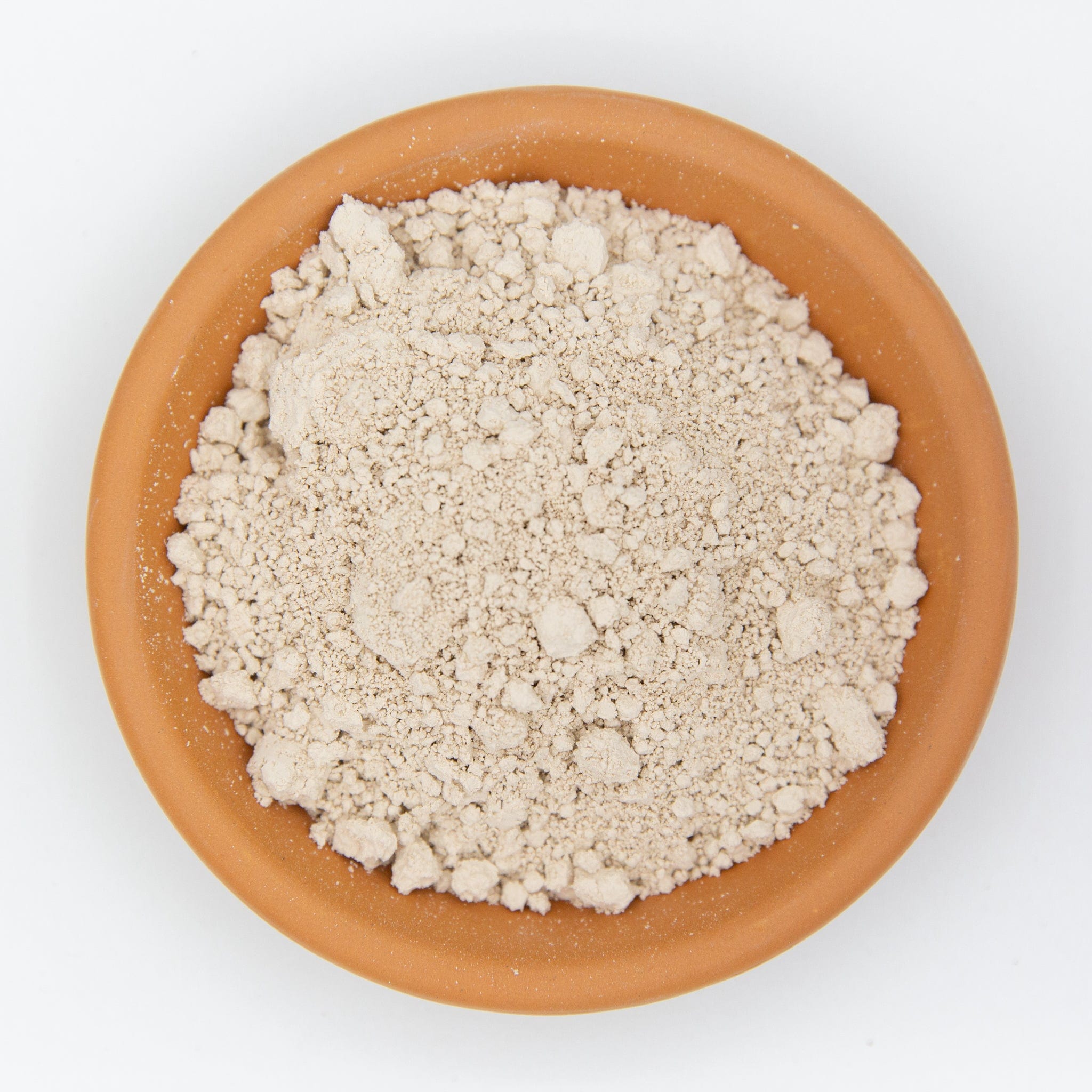Diatomaceous earth (DE) is an all natural rock dust, that is derived from the fossilized remains of ancient freshwater diatoms. DE is known for its unique ability to improve soil & plant fertility by adding cell strengthening silica back to the soil that has been lost over millions of years due to erosion.
It works by absorbing the pests waxes and oils on their cuticle layer leading to death by dehydration. Due to diatomaceous insectacide's high silica content and extremely small particle size, it will also cause the pest to physically degrade due to the silica's shard like structure. This product is the finest grade DE product you can purchase.
For use to control slugs and fungus gnats, simply spread an even layer of diatomaceous fines across your soils surface, and at the bottom of your pot upon planting. Can be dusted on plants suffering from aphid, mealy bug, mites, fleas, ants and many more garden and household pests.
All 5L bags receive a FREE Shaker applicator with your order! One Shaker will be sent per order.
We advise you wear a mask and gloves when handling this product.
Other advantages:
- High in silica, a mineral vital to the health and growth of plants.
- By adding silica and encouraging the growth of advantageous microbes, it enhances the health and fertility of the soil.
- Can be utilised to increase plant yield and general health.
- Can be used to make nutrient-deficient soils more fertile.
- Can aid in enhancing aeration, water retention, and soil structure.
It has the potential to be utilized as a natural pest management method because it can kill soft-bodied insects.
Please note - This product is sold by volume as the weight of this product varies from batch to batch.
FAQs:
What exactly is this “micronized & sprayable” diatomaceous earth?
It’s ultra-fine, amorphous silica DE milled small enough to mix into water as a slurry for spraying; once it dries, it leaves a thin, effective film on leaves/soil.
How does Diatomaceous Earth actually kill pests?
It isn’t a poison. The tiny particles abrade and absorb the waxy oils on an insect’s cuticle so it dries out and dies after contact—works only when dry.
Which pests does Diatomaceous Earth help with?
Great on soft-bodied crawlers: fungus gnats (top of soil), aphids, mealybugs, spider mites, thrips, ants, roaches, and even slugs/snails when conditions stay dry.
Can I spray it or does it have to be dusted on dry?
You can do either. Micronised Diatomaceous Earth mixes into water for spraying; it only starts working after the spray dries and leaves a film on surfaces pests crawl over.
What’s the simple spray/slurry recipe?
Mix ~1 tablespoon Diatomaceous Earth per 1 litre of water + ~1 teaspoon soft/horticultural soap. Agitate frequently (it settles). Spray to full coverage (including undersides) and let it dry. Repeat 2× weekly for 2–3 weeks.
How do I use Diatomaceous Earth for fungus gnats in houseplants?
Top-dress 2–3 mm on the soil surface, bottom-water so the top stays dry for two weeks, and reapply after any top watering. Pair with sticky traps for adults.
Best way to dust plants without making a mess?
Use a puffer/shaker to apply a light film on stems, leaf undersides and the soil surface. Our 5 L size includes a free shaker to make this easy.
Will rain or watering stop Diatomaceous Earth working?
Yes—Diatomaceous Earth must be dry and in contact with the pest. Re-apply after watering, heavy dew, or rain.
Is Diatomaceous Earth safe around bees, butterflies and other beneficials?
Use it carefully. DE is non-selective and can harm beneficial insects on contact—keep it off blooms and target only pest pathways (soil, stems, undersides).
Pool-grade vs food-grade vs “amorphous” DE—what’s the difference?
Use amorphous/food-grade for plants. Never use calcined “pool-grade” (higher crystalline silica; not for plants/people/pets).
Can I use Diatomaceous Earth on edible plants and veggies?
Yes—aim for stems/leaf undersides and avoid dusting open flowers. Rinse produce before eating as you normally would.
How quickly should I see results?
Typically within ~48 hours once the dusted/sprayed film is dry and contacting the pest. Coverage, humidity and pest pressure matter.
Does Diatomaceous Earth work on slugs and snails?
It can help as a dry perimeter barrier, but effectiveness drops to zero when wet—refresh after dew/rain and combine with other slug tactics (traps, habitat cleanup).
What about grasshoppers?
Customers report success dusting foliage/perimeters during outbreaks; reapply after wet weather and combine with netting where possible.
Can I mix Diatomaceous Earth with other products (e.g., soap, neem)?
Yes—using a small amount of horticultural soap in the slurry improves coverage. Many growers also use Diatomaceous Earth alongside other IPM tools (sticky traps, oils) as needed. Follow each label.
Does Diatomaceous Earth kill insect eggs or just the crawlers?
It only works by contact on mobile stages; it doesn’t affect eggs. Keep up applications so newly hatched pests encounter treated surfaces.
How fine is “micronized”—will it clog my sprayer?
It’s deliberately milled for smooth slurries. Still, keep the mix agitated, strain if your sprayer has tiny nozzles, and flush equipment after use.
Indoor use—any tips?
Apply lightly, target pest zones (soil surface, leaf undersides), avoid creating airborne dust, and ventilate. Vacuum up excess after treatment.
Is Diatomaceous Earth safe around kids and pets?
Use food-grade Diatomaceous Earth and common-sense precautions: keep out of reach during application, avoid inhalation, and protect eyes; clean up loose dust.
Do I need PPE when applying?
Yes—wear a P2/N95 mask and eye protection, and avoid raising dust. Handle outdoors or in well-ventilated spaces.
How much should I apply as a dry top-dress?
A thin, even film is enough—think “light dusting,” not a thick layer. For gnats, 2–3 mm on the soil surface works well; re-dust after disturbance.
Will it change my soil’s nutrients?
Diatomaceous Earth supplies plant-available silica and can help soil structure and water management, but it’s not a complete fertiliser. Keep your usual feeding program.
Can I use Diatomaceous Earth in hydroponics?
Use Diatomaceous Earth as a dust/top-dress or perimeter barrier—not in recirculating nutrient tanks where fine particles could accumulate in filters/pumps. (For hydro, deploy it on plant surfaces or media tops only.)
Does Diatomaceous Earth work if I spray it on and it stays wet?
No. Spraying is just for coverage. It must dry on the plant/soil to become active.
How often should I reapply?
For active infestations, apply 2× weekly for 2–3 weeks, then shift to spot treatments as needed—especially after watering or rain.
Can I dust flowers?
Avoid dusting open blooms to protect pollinators. Target stems, leaves (undersides), and soil instead.
Will Diatomaceous Earth help with ants in paving or pot feet?
Yes—dust along ant trails, under pot feet, and around thresholds; refresh after moisture.
Is it okay for pets/poultry areas?
Only use food-grade Diatomaceous Earth and avoid creating dust clouds; keep animals away while applying and until dust settles/dry film forms. Follow local regs and product labels.
Any gotchas with aphids specifically?
Blast colonies off with water first, then apply Diatomaceous Earth to stems/undersides. Keep it off flowers and reapply after watering.
Can insects develop resistance to Diatomaceous Earth?
No—Diatomaceous Earth acts physically, not chemically, so resistance isn’t an issue. Coverage and dryness are the make-or-break factors.
Does Diatomaceous Earth expire or lose potency in the bag?
DE is mineral—store sealed and bone-dry; if it clumps from humidity, break it up and it’s good to go again.
What if I accidentally over-apply and leave a heavy white coating?
No drama—wipe or rinse off non-target areas and re-apply lightly. The goal is a whisper-thin film, not a snowstorm.
Is Diatomaceous Earth enough on its own for bad infestations?
Think of it as a low-tox workhorse inside an IPM plan: combine with sanitation, sticky traps, physical removal, oils/soaps where appropriate, and keep at it for a few weeks.
Why choose Diatomaceous Earth over generic pool filter DE?
Because it’s plant-safe amorphous silica, micronised for spraying, and designed for garden/IPM use—pool-grade is calcined and not safe for plants/people/pets.
Final safety checklist?
Food-grade only; mask & eye protection; avoid inhalation; keep off blooms; reapply after moisture; follow all label directions and local regulations.




